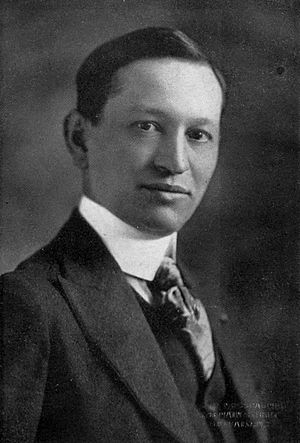Arthur C. Parker facts for kids
Arthur Caswell Parker (born April 5, 1881 – died January 1, 1955) was an important American archaeologist, historian, and expert on Native American culture. He was part Seneca and part Scots-English. From 1924 to 1945, he led the Rochester Museum and Science Center, making it a great place for learning about many subjects. In 1935, he became the first president of the Society for American Archaeology, a group for people who study ancient cultures in the Americas.
Contents
Early Life and Family
Arthur C. Parker was born in 1881 on the Cattaraugus Reservation in western New York. His father, Frederick Ely Parker, was half Seneca. His mother, Geneva Hortenese Griswold, was of Scots-English descent and taught school on the reservation. The Seneca people trace their family through the mother's side. Because Arthur's mother was not Seneca, he was not a tribe member when he was born. However, he was related to important Seneca leaders through his father, including the prophet Handsome Lake.
In 1903, Arthur was officially adopted into the Seneca tribe as an honorary member. He was given the Seneca name Gawaso Wanneh, which means "Big Snowsnake." His grandfather, Nicholson Henry Parker, was an important Seneca leader. Arthur lived with his grandfather on his farm when he was young and learned a lot from him.
Arthur's grand-uncle, Ely S. Parker, was also a famous Seneca leader. He worked with Lewis H. Morgan to study the Iroquois people. Ely Parker later became a brigadier general and secretary to Ulysses S. Grant during the American Civil War. After the war, he was the first Native American to be appointed Commissioner of Indian Affairs.
Arthur Parker was influenced by both his Seneca heritage and the Christian beliefs of his mother's family. He explored his Seneca background to connect with a strong past and fit into American life in the 1900s. Even though his family was Christian, he also saw followers of the Seneca prophet Handsome Lake, who tried to bring back traditional Seneca religion.
Arthur's daughter, Bertha Parker Pallan, also became an archaeologist and ethnologist. She learned by working with others, even without a formal degree. She helped dig at ancient sites and wrote articles about the Yurok Tribe of California.
Learning and Studies
Arthur Parker started school on the reservation. In 1892, his family moved to White Plains, New York, where he attended public school. He finished high school in 1897. Before going to college, he spent a lot of time at the American Museum of Natural History in New York City. There, he met Frederic W. Putnam, an anthropology professor from Harvard University. Putnam encouraged Arthur to study anthropology.
However, Arthur followed his grandfather's wishes and went to Dickinson Seminary in Pennsylvania from 1900 to 1903 to study for the ministry. He left before finishing and worked briefly as a reporter for the New York Sun.
He later worked as an apprentice to archaeologist Mark Harrington. He learned how to dig at sites in New York State. He also volunteered at the Museum of Natural History in his free time.
Career Highlights
Arthur Parker became a field archaeologist at the Peabody Museum in 1903. In 1904, he worked as an ethnologist for the New York State Library, collecting information about the New York Iroquois. In 1906, he became the first archaeologist at the New York State Museum.
In 1911, Arthur Parker helped start the Society of American Indians. This group, which included other Native American leaders like Charles Eastman, aimed to teach the public about Native Americans. During the 1911 New York State Capitol fire, Parker bravely entered the burning building. He used a family tomahawk to break open display cases and save valuable Iroquois artifacts. He managed to rescue about fifty items before the fire made it too dangerous to continue.
From 1915 to 1920, he was the editor of the society's American Indian Magazine. In 1916, he received the Cornplanter Medal for his work.
In 1925, Parker became the director of the Rochester Museum and Science Center. He greatly expanded the museum's collections and research in many areas, such as anthropology, natural history, geology, biology, history, and industry of the Genesee Region. During the Great Depression in the 1930s, he also led the Indian Arts Project, which was funded by the government.
In 1935, Parker was chosen as the first President of the Society for American Archaeology. In 1944, he helped create the National Congress of American Indians, an important organization that works for Native American rights.
Legacy and Honors
Arthur C. Parker received many honors for his work:
- He was an honorary trustee of the New York Historical Association.
- He served as President of the Society of American Indians from 1914 to 1915.
- In 1935, he became the first president of the Society for American Archeology.
- Union College gave him an honorary doctorate degree in 1940.
- Since 1998, the Society for American Archaeology has given out the Arthur C. Parker Scholarship. This scholarship helps Native Americans learn about archaeological methods.
Later Years
After he retired from leading the Rochester museum in 1946, Parker became very involved in Native American affairs. He moved to a place called Nunda-wah-oh, near Naples, New York. He believed his ancestors had lived there, and his home overlooked Canandaigua Lake. He passed away there on New Year's Day, 1955, at 73 years old.
See also
 In Spanish: Arthur C. Parker para niños
In Spanish: Arthur C. Parker para niños


